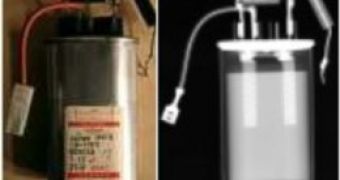Barium titanate is an oxide of barium and titanium with the chemical formula BaTiO3. It is a ferroelectric ceramic material, with a photorefractive effect and piezoelectric properties. It is used as a dielectric material for ceramic capacitors and as a piezoelectric material for microphones and other transducers. As a piezoelectric material, it was largely replaced by lead zirconate titanate, also known as PZT.
But, until recently, scientists had been unable to produce good dispersion of the material within a polymer matrix. By using tailored organic phosphonic acids to encapsulate and modify the surface of the nanoparticles, researchers at the Georgia Institute of Technology's Center for Organic Photonics and Electronics were able to overcome the particle dispersion problem to create uniform nanocomposites.
"Our team has developed nanocomposites that have a remarkable combination of high dielectric constant and high dielectric breakdown strength," said Joseph W. Perry, a professor in the Georgia Tech School of Chemistry and Biochemistry and the Center for Organic Photonics and Electronics. "For capacitors and related applications, the amount of energy you can store in a material is related to those two factors."
A capacitor (formerly known as condenser)is an electrical device that can store energy in the electric field between a pair of closely-spaced conductors (called plates). When voltage is applied to the capacitor, electric charges of equal magnitude, but opposite polarity, build up on each plate.
Capacitors are used in electrical circuits as energy-storage devices. They can store electric energy when disconnected from its charging circuit, so it can be used like a temporary battery, so they are commonly used in electronic devices to maintain power supply while batteries are being changed. (This prevents loss of information in volatile memory). They can also be used to differentiate between high-frequency and low-frequency signals and this makes them useful in electronic filters.
The new nanocomposite materials have been tested at frequencies of up to one megahertz and Perry says operation at even higher frequencies may be possible. Though the new materials could have commercial applications without further improvement, their most important contribution may be in demonstrating the new encapsulation technique, which could have broad applications in other nanocomposite materials.
Due to their ability to store almost twice as much energy and to rapidly discharge it, the new capacitors could most probably be used in a variety of consumer products such as displays, computers and cellular telephones. And because of the increasing demands for electrical energy to power vehicles and new equipment, they would also have important military applications.
"This work opens a door to effectively exploit this type of particle in nanocomposites using the coating technology we have demonstrated," explained Perry. "There are many ways we can envision making advances beyond what we've done already."

 14 DAY TRIAL //
14 DAY TRIAL //